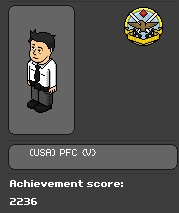Hello everybody!
Today is a sad day because today’s post is my final post – which means I’ll be concluding my final thoughts, as well as tying my data and findings back to my thesis.
In the beginning, I stated that my thesis would argue that the factor of anonomity for the citizens of Habbo Hotel allows for a realistic formation of identity – one that parallels the users real-life identity. In contrast, Twitter users construct an aspirational identity (alternatively referred to as “the best-self” or Goffman’s “front-stage”) in which they market to their social network, as well as the larger Twitter community.
Looking back at my thesis, I don’t think I was completely wrong, yet I don’t think I was completely right either.
I think time and time again, I was able to justify my thesis – especially through the participant observation stages. During my Twitter observation for example, I noted consistent trends of “Me-Tweets” where users would only Tweet positive things about themselves to their followers. This trend continued when I analyzed community Twitter accounts, where the notion of the ‘favourite’ or ‘re-tweet’ was used as a means of validation for the aspirational identity these users would create for themselves. Interviewee B also justified my thesis through the majority of her answers – e.g., purposely constructing Tweets to receive the ‘re-tweets’ and ‘favourites’, observing others who Tweet in a way that contrasts with their real-life identity, etc.
My thesis pertaining to Habbo was also justified, when I noted a Habbo user confiding to another user about their real-life identity due to the factors of anonymity, escapism, and reciprocity. Even during the Habbo interviews, the amount of users who stated the contrast between their online and offline identities was significant – especially when they themselves noted the reason for this was due to the factors of escapism and anonymity.
However, during the Twitter interview, interviewee A stated something that put my entire study into perspective.
“Something one must understand is that you cannot compare your profile or how you act on Twitter to how you act in real life; “life offline” is so broad and there are so many aspects to it so it’s impossible to try to compare life as a whole to Twitter…They’re just completely different scenarios [reality and ‘virtuality’] and cannot be compared to prove someone’s authenticity as a person.”
Although I agree that in the larger picture my thesis is justifiable in terms of how identity is constructed and functions between these two virtual communities, I do agree that identity is subjective to each individual user in both virtual communities. You can see that in both interviews, users approached the notion of identity in ways that contested my thesis. For some Twitter users, the platform is used as an extension of their real-life identity – an alternative or virtual setting to be themselves. Habbo functions similarly in the way that many users use it to be someone they’re not – e.g., joining mobs, role-playing as babies or animals, etc.
So to conclude, as stated by interviewee A, inevitably, it is difficult to portray your entire identity on a virtual platform – especially since the notion of identity is subjective to each individual user.









